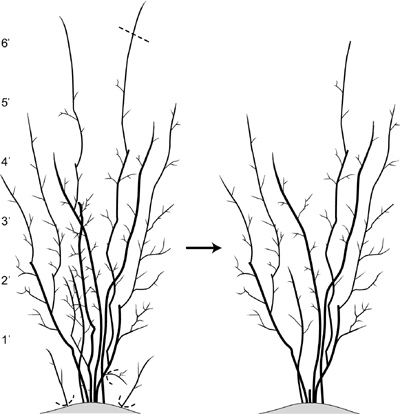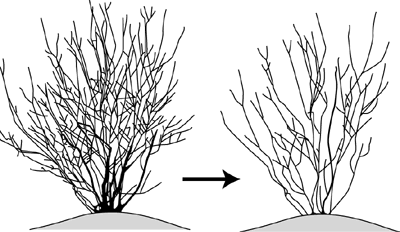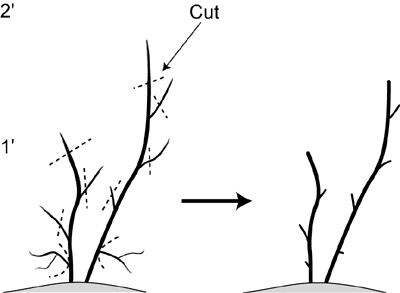General Information
Blueberries are becoming increasingly popular due to their delicious and healthy fruit. Among other things, they are high in antioxidants, have anti-aging activity, promote healthy urinary tracts, improve vision and help fight heart disease. With a little effort, these "wonder berries" can be produced by home gardeners throughout Georgia. This brief publication gives a few helpful hints to get started.
When it comes to selecting blueberries for the home garden, rabbiteye types are the best choice. This species is actually native to Georgia, and there are varieties than can be produced across the state from the coastal flatwoods to the mountain regions. Southern highbush blueberries are grown commercially in South Georgia, but this species can require more care than rabbiteye types and are very prone to attack by deer and birds because they ripen so early in the season. Therefore, these can be less desirable choices for the home gardener, although there are newer varieties to try if one is interested. On sites in the mountains of North Georgia, northern highbush blueberries can be grown. This species often blooms later than rabbiteyes, so they may be useful for more freeze-prone sites in the mountains. However, northern highbush blueberries generally do not perform well in the piedmont and southern areas of Georgia due to insufficient winter chilling and hot summer temperatures. Make sure and purchase the type of blueberry most suitable to the intended growing area.
One of the advantages of home garden blueberry plants is they seldom require spraying for insects or diseases in most areas of the state. Under good management, blueberry bushes will produce some fruit the second or third year after transplanting. By the sixth year they can yield as much as 2 gallons per plant. The yield will continue to increase for several years as the plants get larger if given good care. Plants can last 10 to 15 years or longer if managed well.
Varieties
Rabbiteye
One of the most important things to remember about starting rabbiteye blueberries is to plant more than one variety for cross-pollination to promote adequate fruit set. Also, choosing varieties from the different ripening categories provides a broad harvest season. Rabbiteye varieties have been bred for years, and many of the varieties listed are somewhat antiquated. Newer varieties are listed in bold, and are highly recommended to provide homeowners some of the latest improvements offered in blueberry varieties.
| Early Season | Mid-season | Late Season |
| Austin Alapaha Climax Premier Vernon Titan |
Brightwell |
Baldwin Centurion Ochlockonee |
Climax, Premier, and Vernon may flower too early for growing in the mountain regions, resulting in frequent spring frost/freeze damage. Titan is a very new variety (released in 2011) and may take a little time to become widely available. However, it is the largest fruited rabbiteye variety that has been developed to date. Vernon also has large berries. Alapaha and Ochlockonee have medium sized berries with good eating quality and less pronounced seeds than varieties such as Austin and Brightwell. Most of these varieties have been bred for adaptation to Georgia and are highly recommended. If your garden center does not carry a desired variety, encourage them to update their blueberry variety selection.
Southern Highbush
Even though southern highbush can be challenging to grow, they do offer some very early ripening fruit. Mulching with pine bark or pine straw can increase the vigor of southern highbush. Take care not to over water this species, especially in poorly drained soils. The varieties listed below are suggested for areas of South Georgia up through the Piedmont region. These are discouraged for use in the colder mountain regions of the state. Many southern highbush are self fertile, however, the planting of multiple varieties is still recommended for improved fruit set. Early season southern highbush will ripen 2 to 3 weeks before early rabbiteyes, and mid-season varieties will ripen 8 to 12 days before early rabbiteyes. Again, newer varieties are listed in bold.
| Early Season | Mid-season |
| Suziblue Palmetto O'Neal |
Camellia Jubilee Magnolia |
Palmetto is a medium sized berry that is noteworthy for its outstanding flavor. Suziblue has very large fruit as does Camellia. Jubilee and Magnolia are smaller fruited varieties with good plant vigor. As mentioned earlier, bird and deer feeding may be a problem with southern highbush, so using appropriate protection methods is strongly suggested.
Northern Highbush
Northern highbush blueberries are as a rule self-fertile; however, as with southern highbush, larger and earlier ripening berries result if several cultivars are interplanted for cross-pollination. They can be grown in the mountains of North Georgia if soil conditions are met (pine bark mulching recommended) and if birds and deer are controlled. Early and mid-season northern highbush varieties ripen ahead of the earliest rabbiteyes in the mountain region.
| Early Season | Mid-season | Late Season |
| Collins Duke Earliblue Patriot Spartan |
Berkeley Bluecrop Bluehaven Blueray Legacy |
Coville Elliot Jersey |
Ornamental Varieties
For the home gardener desiring something unique, edible ornamental blueberries have been developed recently to offer the opportunity to "surround yourself with flavorful beauty." Two of the newest varieties are Blue Suede™ and Summer Sunset™. Blue Suede™ is a southern highbush having sky blue fruit, large flavorful berries, and striking autumn leaf color development, giving multi-season home landscape appeal. Summer Sunset™ is a rabbiteye hybrid with notable red winter stem color, pink flowers, and multi-colored berries that transition from green to yellow to orange to red as they ripen to a midnight blue. This variety offers a colorful, edible landscape for novel appeal.
Planting and Care
- Obtain your plants in time for winter transplanting.
- Select a site with sun for at least one-half the day. Blueberries will grow in shady spots, but fruit production will be poor.
- Blueberries require a soil pH of 4.5 to 5.2 for best growth. If your soil pH is in the range of 5.3 to 6.0, sulfur can be applied six months before planting to lower the pH. Refer to a sulfur application chart for exact amounts for your specific pH. Sulfur can also be applied after planting to the soil surface but not mixed with the soil. Rates of up to 0.7 lbs per 100 square feet can be used yearly, if needed. If the initial soil pH is above 6.0, growing blueberries will be difficult unless massive amounts of peat moss or milled pine bark are mixed with the soil. You can find out what your soil pH is by taking a sample to your county Extension office.
- A standard spacing for rabbiteye blueberries is 5 to 6 ft between plants in a row and 11 to 12 ft between rows. For highbush (southern or northern) a spacing of 4 ft between plants in a row and 10 ft between rows is suggested. If developing individual specimen plants give plants a 25 to 40 ft2 area each.
- Till the soil 8 to 12 in. deep in a band at least 3 to 4 ft wide. If the site is excessively wet, plant on a raised bed 6 to 12 in. high and 3 to 4 ft wide.
- Mix wetted peat moss or milled pine bark with the soil in each planting hole (2 to 4 gallons depending on size of the hole). Do not use any agriculture lime or potting mixes that have lime added (most commercial potting soils). Remember, blueberries require an acid soil.
- Pot-bound plants must have the root system loosened considerably prior to transplanting. Plants that are not pot-bound can be planted directly without breaking up root system.
- Transplant the same depth as the plants grew in the nursery. Do not bury too deep. Firm the soil after planting.
- Prune plant back 1/3 to 1/2 at planting. Remove low twiggy growth entirely and tip remaining shoots to remove all the flower buds (Figure 1).
- Do not apply any fertilizer at transplanting. During the first year of establishment, and after leaves emerge and new growth begins (late March to early April), apply 2 ounces of azalea special fertilizer (4-8-8) or 1 ounce of 12-4-8 or 10-10-10 per plant. Fertilize at the same rate again in May and July if sufficient rainfall or irrigation has occurred. Never heap fertilizer at the base of plants, instead spread the fertilizer evenly over a circle 18 in. in diameter with the plant in the center.
 Figure 2: Cane renewal of rabbiteye blueberries 6 ft and taller. Remove one to three of the oldest, tallest canes each winter or about 20 percent of the canopy. In addition, excessively tall canes can be pruned back to 6 to 8 ft.
Figure 2: Cane renewal of rabbiteye blueberries 6 ft and taller. Remove one to three of the oldest, tallest canes each winter or about 20 percent of the canopy. In addition, excessively tall canes can be pruned back to 6 to 8 ft.- The first year, remove any flowers or fruit that escaped the pruning process. This allows plants to expend energy on establishment rather than producing fruit.
- Keep weeds and grass away from plants. A weed-free area of at least 3 ft by 3 ft is beneficial. Mulching with pine bark or pine straw is very beneficial for helping with weed control and improving plant vigor. A mulch layer of 3 to 4 in. works very well.
- In March and July of the second year apply 2 ounces of 10-10-10 or 12-4-8 or 3 to 4 ounces of azalea special fertilizer (4-8-8). Do not over-fertilize; fertilizer damages young blueberries easily until they are established. Spread the fertilizer evenly over a circle 24 in. in diameter with the plant in the center.
- From the third season on, base the amount of fertilizer applied on the size of the bushes. If your soil tests very high in phosphorus, use 12-4-8. If your soil tests low or medium in phosphorus, use 10-10-10. Use "premium grade" fertilizer if possible; this type contains secondary and micronutrients that may be needed. Apply 1 oz of 12-4-8 or 10-10-10 per foot of bush height at the time of bud break in the spring and after harvest in the summer. Continue to increase the amount of fertilizer applied yearly until the bushes are 6 to 8 ft tall. Bushes 6 ft tall or taller should receive the maximum rate of 6 ounces of fertilizer per bush. Spread the fertilizer evenly under and around the bushes.
- After establishment, rabbiteye blueberries require little pruning until they reach about 4 to 6 ft in height. At this point, a cane renewal pruning program should be started. Remove one to three of the largest canes each winter at 0 to 24 in. from ground level or a total of about 20 percent of the canopy (Figure 2). In areas where stem borers are a problem, make the pruning cuts at 24 in. Over a period of 5 years the bush will be totally renewed. New, more productive canes will sprout from the old canes and will sprout below ground level. In addition, excessively tall canes can be pruned back to 6 ft each winter.
- Water the plants throughout the growing season when rainfall is not adequate. Irrigation of young plants is especially important. Adequate water is essential for plant growth and important for fruit bud formation that occurs in the fall.
- Blueberries seldom require spraying for pests. If, however, pests attack them, see your county Extension agent for pest-control recommendations.
- Cultivated blueberries are an almost perfect fruit. They are easy to pick, and the berries can be large. To store them frozen, first freeze them on a cookie sheet as a single layer of individual berries. After initial freezing, pack the berries dry in containers and place in the freezer. A small amount of frozen berries can be removed from the container and washed afterward.
Additional Recommendations for Highbush Blueberries
Highbush blueberries generally perform more satisfactorily on lighter (sandy to sandy loam) soils because of the need for good internal drainage to avoid infection by root rot diseases. Generally, success with highbush can be improved by following these additional suggestions:
 Figure 3: Cane renewal pruning and branch thinning of highbush blueberries 4 ft and taller, before (left) and after pruning. Remove low, spreading branches and excessively twiggy growth with too many flower buds.
Figure 3: Cane renewal pruning and branch thinning of highbush blueberries 4 ft and taller, before (left) and after pruning. Remove low, spreading branches and excessively twiggy growth with too many flower buds.- Till 4 to 6 in. of peat moss, milled pine bark or well-rotted pine sawdust into the soil in a band 3 to 4 ft wide down the row prior to planting.
- Keep the plants mulched 4 to 6 in. deep with pine bark nuggets, pine straw or pine sawdust.
- Irrigate with sprinklers or otherwise water regularly if rainfall is insufficient.
- Prune newly set bushes as previously indicated in Figure 1. Also, in the second season remove all or nearly all flower buds to help foster better plant establishment. You can do this by tipping or pruning shoots in second winter. This will encourage the bush to grow faster by not bearing a crop in the second year.
- Highbush blueberries often over produce, and annual pruning is usually necessary to keep the bushes healthy. On 3- and 4-year-old plants, remove low spreading branches and excessively twiggy growth with too many flower buds.
- When the bushes are about 4 or 5 ft tall, begin a cane-renewal pruning program (Figure 3). First remove the oldest, weakest canes or diseased canes entirely. Then, among the remaining canes, start with the older ones and prune approximately two per year back either to strong laterals or to within 1 ft of the ground. New strong canes will usually develop below the cut. Over a period of four or 5 years, a new rejuvenated bush framework will be developed.
Status and Revision History
Published on May 01, 1999
Unpublished/Removed on Feb 24, 2009
Published on Apr 20, 2009
Published with Minor Revisions on Mar 20, 2012
Published with Full Review on Mar 28, 2017



























































 Figure 1: Pruning at planting. Remove low, twiggy growth entirely and tip remaining shoots to remove all the flower buds. About 1/2 to 1/3 of the plant top should be removed in this process Mulch 4 in. deep with pine needles or pine bark after planting.
Figure 1: Pruning at planting. Remove low, twiggy growth entirely and tip remaining shoots to remove all the flower buds. About 1/2 to 1/3 of the plant top should be removed in this process Mulch 4 in. deep with pine needles or pine bark after planting.